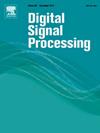Secrecy performance of D2D assisted cooperative uplink NOMA system with optimal power allocation strategy
IF 2.9
3区 工程技术
Q2 ENGINEERING, ELECTRICAL & ELECTRONIC
引用次数: 0
Abstract
This paper investigates the physical-layer security (PLS) aspects of the uplink cooperative non-orthogonal multiple access (NOMA) system in the context of two user scenario. More specifically, this work employs device-to-device (D2D) pair users (i.e., , and ) to further improve the spectral efficiency (SE) of the proposed cooperative uplink NOMA (CU-NOMA) system. One D2D user acts as a decode-and-forward relay, improving the performance of both the cell-edge user (CU) and another D2D user i.e., (). We analyze the secrecy performance of CU and D2 under perfect and imperfect successive interference cancellation (SIC), and optimizes power allocation (PA) to boost the performance. The proposed CU-NOMA system is evaluated in terms of its performance metrics like ergodic secrecy capacity (ESC), ergodic secrecy sum capacity (ESSC), non-zero secrecy capacity (NSC), effective secrecy throughput (EST), and secrecy outage probability (SOP) under the presence of an external eavesdropper (Eav). In addition, this work derives the closed-form analytical expressions of ESC, NSC, EST, and SOP metrics for both CU and under perfect SIC (pSIC) and imperfect (ipSIC) cases in order to characterize the secrecy performance of the proposed secure CU-NOMA network. Further, the outcomes of the simulations are shown as evidence for both the validation of the mathematical analysis and the performance of the method being suggested. The simulation result analysis of this work infers that the secrecy performance of CU-NOMA system with optimal PA exhibits superior performance than that of the fixed PA scheme.
采用最优功率分配策略的 D2D 辅助合作上行 NOMA 系统的保密性能
本文研究了双用户场景下上行链路合作非正交多址接入(NOMA)系统的物理层安全性(PLS)问题。更具体地说,这项工作采用了设备对设备(D2D)对用户(即 D1 和 D2),以进一步提高拟议的合作上行链路非正交多址接入(CU-NOMA)系统的频谱效率(SE)。一个 D2D 用户充当解码和前向中继,提高了小区边缘用户(CU)和另一个 D2D 用户(D2)的性能。我们分析了完美和不完美连续干扰消除(SIC)条件下 CU 和 D2 的保密性能,并优化了功率分配(PA)以提高性能。在外部窃听者(Eav)存在的情况下,对所提出的 CU-NOMA 系统的性能指标进行了评估,如遍历保密容量(ESC)、遍历保密总和容量(ESSC)、非零保密容量(NSC)、有效保密吞吐量(EST)和保密中断概率(SOP)。此外,这项研究还推导出了完美 SIC(pSIC)和不完美 SIC(ipSIC)情况下 CU 和 D2 的 ESC、NSC、EST 和 SOP 指标的闭式解析表达式,以描述所提出的安全 CU-NOMA 网络的保密性能。此外,仿真结果还证明了数学分析的有效性和所建议方法的性能。这项工作的仿真结果分析推断出,采用最佳功率放大器的 CU-NOMA 系统的保密性能比固定功率放大器方案更优越。
本文章由计算机程序翻译,如有差异,请以英文原文为准。
求助全文
约1分钟内获得全文
求助全文
来源期刊

Digital Signal Processing
工程技术-工程:电子与电气
CiteScore
5.30
自引率
17.20%
发文量
435
审稿时长
66 days
期刊介绍:
Digital Signal Processing: A Review Journal is one of the oldest and most established journals in the field of signal processing yet it aims to be the most innovative. The Journal invites top quality research articles at the frontiers of research in all aspects of signal processing. Our objective is to provide a platform for the publication of ground-breaking research in signal processing with both academic and industrial appeal.
The journal has a special emphasis on statistical signal processing methodology such as Bayesian signal processing, and encourages articles on emerging applications of signal processing such as:
• big data• machine learning• internet of things• information security• systems biology and computational biology,• financial time series analysis,• autonomous vehicles,• quantum computing,• neuromorphic engineering,• human-computer interaction and intelligent user interfaces,• environmental signal processing,• geophysical signal processing including seismic signal processing,• chemioinformatics and bioinformatics,• audio, visual and performance arts,• disaster management and prevention,• renewable energy,
 求助内容:
求助内容: 应助结果提醒方式:
应助结果提醒方式:


